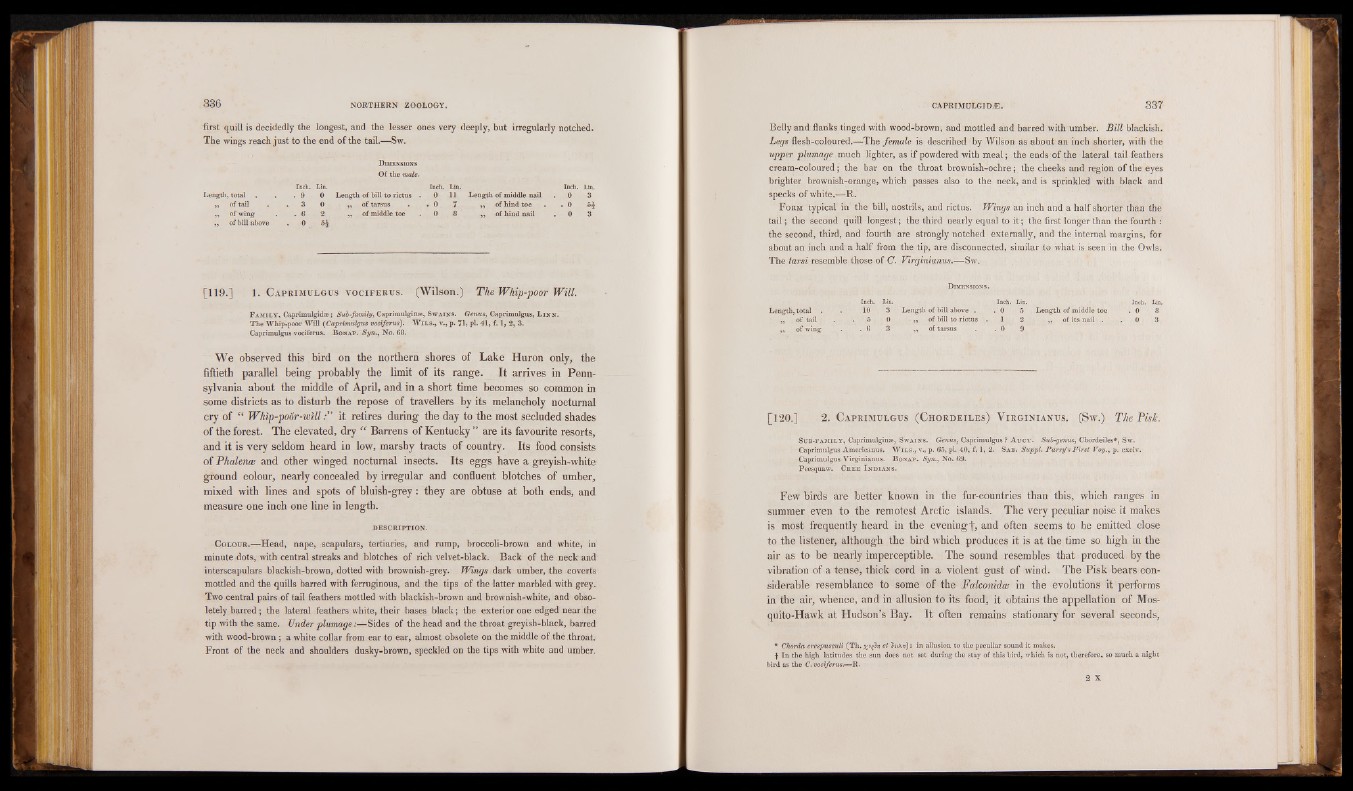
first quill is decidedly the longest, and the lesser ones very deeply, but irregularly notched.
The wings reach just to the end of the tail.—Sw.
Dimensions
Of the male.
Inch. Lin. Length, total Inch. Lin. Inch. Lin. . 9 0 Length of bill to rictus . 0 11 Length of middle nail . 0 3
„ of tail . 3 0 „ of tarsus . . 0 7 „ of hind toe . 0 54 ,, of wing . . 6 2 ,, of middle toe . 0 8 „ of hind nail . 0 3
„ of bill above . 0
[119.] 1. C a p r im u l g u s v o c if e r u s . (Wilson.)w The Whip-poor Will.
F a m il y , Caprimulgidse; Sub-family, Caprimulginae, Swains. Genus, Caprimulgus, L in n .
The Whip-poor Will (Caprimulgus vociferus). Wils., v., p. 71j ph 41, f. 1, 2, 3.
Caprimulgus vociferus. Bonap. Syn., No. 68.
We observed this bird on the northern shores of Lake Huron only, the
fiftieth parallel being probably the limit of its range. It arrives in Pennsylvania
about the middle of April, and in a short time becomes so common in
some districts as to disturb the repose of travellers by its melancholy nocturnal
cry of “ W h ip -p o o r -w illit retires during the day to the most secluded shades
of the forest. The elevated, dry “ Barrens of Kentucky ” are its favourite resorts,
and it is very seldom heard in low, marshy tracts of country. Its food consists
of Phalence and other winged nocturnal insects. Its eggs have a greyish-white
ground colour, nearly concealed by irregular and confluent blotches of umber,
mixed with lines and spots of bluish-grey: they are obtuse at both ends, and
measure one inch one line in length.
DESCRIPTION.
Colour.—Head, nape, scapulars, tertiaries, and rump, broccoli-brown and white, in
minute dots, with central streaks and blotches of rich velvet-black. Back of the neck and
interscapulars blackish-brown, dotted with brownish-grey. Wings dark umber, the coverts
mottled and the quills barred with ferruginous, and the tips of the latter marbled with grey.
Two central pairs of tail feathers mottled with blackish-brown and brownish-white, and obso-
letely barred ; the lateral feathers white, their bases black; the exterior one edged near the
tip with the same. Under plumage .-—Sides of the head and the throat greyish-black, barred
with wood-brown ; a white collar from ear to ear, almost obsolete on the middle of the throat.
Front of the neck and shoulders dusky-brown, speckled on the tips with white and umber.
Belly and flanks tinged with wood-brown, and mottled and barred with umber. Bill blackish.
Legs flesh-coloured.—The female is described by Wilson as about an inch shorter, with the
upper plumage much lighter, as if powdered with meal; the ends of the lateral tail -feathers
cream-coloured; the bar on the throat brownish-ochre; the cheeks and. region of the eyes
brighter brownish-orange, which passes also to the neck, and is sprinkled with black and
specks of white.—R.
F orm typical in the bill, nostrils, and rictus. Wings an inch and a half shorter than the
tail; the second quill longest; the third nearly equal to it; the first longer than the fourth :
the second, third, and fourth are strongly notched externally, and the internal margins, for
about an inch and a half from the tip, are disconnected, similar :to what is seen in the Owls.
The tarsi resemble those of C. Virginianus.—Sw.
Dimensions.
Length, total 10
Lin.
3 Length of bill above .
Inch. Lin. . 0 5 Length of middle toe
Inch. Lin.
. 0 8
„ , of tail ’ 5 , 0 ,, of bill to rictus . 1 2 . „ of its nail . 0 3
,, of wing . 6 3 „ of tarsus . 0 9
[1 2 0 .] 2. C a p r im u l g u s (C h o r d e il e s ) V ir g in ia n u s . , (Sw.) The Pisk.
Sub-f a m il y , Caprimulgin®, Swains. Genus, Caprimulgus ? A u c t . Sub-genus, Chordeiles*, Sw.
Caprimulgus Americanus. W il s ., v., p. 65, pi.:40, fy 1, 2. Sab. Suppl. Parry's First Voy., p. cxciv.
Caprimulgus Virginianus. B onap. Syn., No. 69.
Peesquaw. Cb.e e I n d ia n s .
Few birds are better known in the fur-countries than this, which ranges in
summer even to the remotest Arctic islands. The very peculiar noise it makes
is most frequently heard in the evening]-, and often seems to be emitted close
to the listener, although the bird which produces it is at the time so high in the
air as to be nearly imperceptible. The sound resembles that produced by the
vibration of a tense, thick cord in a violent gust of wind. The Pisk bears considerable
resemblance to some of the Falconidw in the evolutions it performs
in the air, whence, and in allusion to its food, it obtains the appellation of Mosquito
Hawk at Hudson’s Bay. It often remains stationary for several seconds,
* Chorda crespusculi (Th. et hiXp) : in allusion to the peculiar sound it makes.
f In the high latitudes the sun does not set during the stay of this bird, which is not, therefore, so much a night
bird as the C. vociferus.—R.